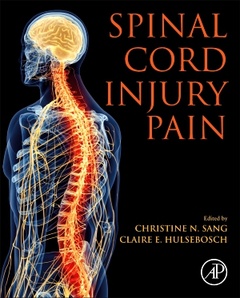Spinal Cord Injury Pain

Spinal Cord Injury Pain presents the basis for preclinical and clinical investigations, along with strategies for new approaches in the treatment of central neuropathic pain. Contributors from the private sector and academia provide a comprehensive review of state-of-the-art research in this challenging space. Topics include Epidemiology of Chronic Pain Following SCI, experimental models and mechanisms of chronic pain in SCI, and new targets and technologies. This book serves as a resource for continued translational research that will result in novel approaches and treatments that improve function and quality of life for individuals with CNP/SCI.
Despite a better understanding of the complexity of mechanisms of CNP/SCI, improved medical and surgical management of SCI, and the subsequent acceleration of the identification of new targets and the development of novel analgesics, there is still a great unmet clinical need in the area of CNP following SCI. Hence, this book is a welcomed addition to current research and developments.
Part I: Approaches to the development of new technologies
1. Electrophysiological phenotyping of neuropathic pain following spinal cord injury 2. Spinal cord injury pain: A retrospective 3. Central neuropathic pain after spinal cord injury: Therapeutic opportunities. A brief history and temporal progression of the pathophysiology from acute trauma to chronic conditions 4. Mechanisms of pain below the level of spinal cord injury (SCI) 5. Devil’s advocate: Why past and future animal models of neuropathic pain in spinal cord injury are without merit 6. Counterpoint: Why animal models are indispensable for translational pain research in spinal cord injury 7. Behavioral assays of pain in rodent models of spinal cord injury 8. Biomarker signatures for neuropathic pain after SCI 9. Decoding nociception in the spinal cord: Computer modeling and machine learning 10. EEG biomarkers of pain and applications of machine learning 11. Perspectives on preclinical evidence for translation in SCI 12. Screening and treatment of neuropathic pain after SCI
Part II: Mechanisms of CNP following SCISection 1: Spinal and supraspinal mechanisms 13. Spinal GABA mechanism in neuropathic pain after spinal cord injury 14. Glial activation and neuropathic pain 15. Mechanisms of CNP following SCI: Chemokines in neuronal-glial cell interaction
Section 2: Peripheral mechanisms16. When soft touch hurts: How hugs become painful after spinal cord injury 17. Peripheral mechanisms contributing to central neuropathic pain following SCI
Section 3: Clinical applications of novel targets and technologies 18. Human neural stem cell transplantation for improved recovery after spinal cord injury 19. Cell transplantation for reducing neuropathic pain after SCI 20. Gene therapy of neuropathic pain after spinal cord injury 21. Exercise as a therapeutic intervention for neuropathic pain after spinal cord injury
Claire E. Hulsebosch, Ph.D. is Professor, Department of Neurobiology and Anatomy, McGovern Medical School, The University of Texas Health Science Center at Houston. She pioneered the concept of nerve cell process reorganization and the formation of new nerve connection
- Provides a comprehensive resource for novel approaches and treatments that improve function and quality of life for individuals with CNP/SCI
- Includes contributors from the private sector and academia
- Covers epidemiology of chronic pain following SCI, experimental models, mechanisms of chronic pain in SCI, and new targets and technologies
Date de parution : 10-2021
Ouvrage de 505 p.
19x23.4 cm
Mots-clés :
Spinal Cord Injury; Pain; Central Neuropathic Pain; novel analgesics



